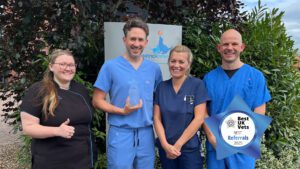Objective
To describe acute correction of antebrachial angular and rotational limb de- formities (ARLD) using a new external skeletal fixator (ESF).
Methods
Dogs that were presented with lameness caused by ARLD were treated by radial and ulnar osteotomies and acute real- ignment. A modified type-1b ESF incorporat- ing double arches (DA-ESF) and a novel con- necting configuration facilitated alignment with six degrees of freedom. Bilateral deform- ities were corrected surgically in the same session. Aseptic preparation of both antebra- chii allowed comparison of limb alignment. Radiographic evaluation was performed using centre of rotation of angulation (CORA) methodology.
Results
Thirty-five antebrachii (22 dogs) underwent surgery. Postoperative limb func- tion was graded as good (n = 31), fair (n = 2), or poor (n = 2). Persistent medial carpal insta- bility was associated with a suboptimal out- come. Postoperative radiographic images of the frontal and sagittal plane joint angles and elbow-to-carpus translation were compared with values that were reported in previous studies, and were within published reference ranges in most cases. Complications included delayed radial osteotomy union (n = 5), de- layed ulnar osteotomy union (n = 2) and im- plant-associated morbidity (n = 3).
Clinical relevance
A practical technique for acute correction of complex antebrachial ARLD is suggested, incorporating a new con- figurationofESF.Putativelimitationsofradio- graphic planning using CORA may be com- pensated by careful attention to intra-oper- ative visual an
Research authors
Noel Fitzpatrick Christos Nikolaou Mike Farrell K. Perry Sarah Girling T. J. Smith Russell Yeadon






